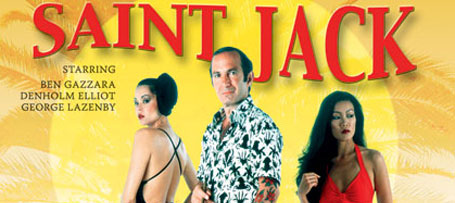It was pure serendipity: I walked into Quinceanera simply because I had time to kill, not because I was expecting anything gay. Contrary to habit, I had not even checked out reviews of the film prior to watching it, so it was a surprise to see a gay subplot in it.
It went as far as showing two men lying in bed seeped in post-coital glow. It also had lines about "8 inches." By the way, gay bits apart, it's a very good film. Excellent storytelling.
Quinceanera was rated M18, a classification that meant one had to be at least 18 years old to enter. No scenes were cut.
At HMV the music store, on the third level where DVDs are found, was a rack marked "Best sellers" just inside the main door. Saint Jack was boldly advertised and amply stocked. It too was marked M18, with no scenes cut.
Saint Jack is an old movie, made in 1978, but it has a special place in Singapore because it was shot entirely here, with all outdoor scenes in real streets and alleyways. While, like Quinceanera, its main narrative is not gay, it has a scene from the old Bugis Street complete with real transsexual hookers in them, followed by one in a Telok Kurau house where two of them performed a fully nude "sexy dance" à la Patpong. The climax of the story involves a rentboy picked up late at night on Orchard Road by an American senator, going up to the pre-notified hotel room, and being photographed by a spy camera (only rear nudity).
All rather titillating. But once again, titillating bits apart, Saint Jack is also a remarkably good film. The movie was banned for 20 years, and the DVD has only recently been given its M18 rating.
In September 2005, theatre company Luna-ID staged Quills, an acclaimed play by Doug Wright. Revolving around the fictional contest of will and wits between an imprisoned Marquis the Sade and Abbé de Coulmier, the play had long scenes of full nudity, front and back. Rated RA18, it garnered excellent reviews in the mainstream media.

What gives?
Classification system
The first thing that comes to mind is that Singapore has a rating system for movies, and a similar but separate one for theatre. There is no rating system for books, magazines and other printed materials; for these, it's a simple toggle between banned and not banned.
For film, the available classifications are G, PG, NC16, M18 and R21. However, films can also be banned if it doesn't even fit into R21.
For the theatre and other arts events, the categories are "allowed," "allowed with advisory" and RA18. Productions can also be banned.
For books and printed materials, bans are imposed if they are "objectionable on moral, racial and religious ground, or are detrimental to Singapore's national interests," as stated on the MDA's website.
The availability of classification seems to make all the difference, allowing for a more graduated response from the censors.
It's also clearer to civil servants, either through written explanation or precedents, what each category represents, giving them more references by which to make a decision. Civil servants, the world over, are not famous for taking risks in their decision making; they prefer the comfort of looking up regulations or at least past examples. Sure, every film or play that is submitted to them is unique, but the chance of going wrong with their decision - where going wrong means getting a scolding from their superiors or political masters after the fact - is less, since the classification pigeon-holes are more defined.
With books and magazines, they are left with just one vague guideline: "objectionable on moral, racial and religious ground, or are detrimental to Singapore's national interests." It is no wonder then that civil servants may prefer to play safe rather than take risks and put their careers on the line.
In actual fact, the 2002 Censorship Review Committee's report - there is one such review every 10 years - suggested "allow[ing] permissible publications where content may be sensitive to some, through suitable channels to adult readers." However, it did not recommend a classification system for books, magazines, etc.
In hindsight, this might have been a fatal cop-out. Allowing "sensitive" content on a case by case basis would not only be contingent upon negotiation between publisher or importer and the MDA, but would also require the MDA to show unaccustomed flexibility sans rulebook. It would be difficult to expect exemption decisions.
Negotiation
This negotiation angle is also pertinent. Book publishers and importers in Singapore seldom see much profit in their trade; the volumes are small and margins thin. Hence, they may not see any point in investing time and effort in persuading the MDA. Arts practitioners are quite different, often armed with a sense of ownership over their work, and sometimes, they even have the National Arts Council on their side. As a result, they are typically much more persistent.
Film distributors are probably somewhere in between.
This may explain how theatre practitioners in Singapore has, over the years, won much more latitude for themselves, to the extent that Quills could be staged. Additionally, theatre is relatively expensive and the MDA may feel that the audience is limited; thus more leeway can be given.
Films, before and after the last review
Film too has seen a degree of relaxation since the 2002 censorship review, most of whose recommendations were implemented in 2003 and 2004. Content which in the past might have been banned or slapped with an R21 rating - audiences must be at least 21 years old - now seem to given the new M18 rating.
The old standards were:
- Content that promotes homosexuality to be disallowed.
- Films with non-exploitative homosexual theme or scenes allowed only at film festivals.
(If the above language strikes you as impenetrable, you're not alone.)
The current standards are premised on these broad principles, when it comes to homosexuality:
- Take a more flexible and contextual approach when dealing with homosexual themes and scenes in content.
- Allow greater leeway for adults, through suitable channels, to access such content provided it is not exploitative.
Regarding "sexual content":
- To give greater leeway for [sexual] content targeting the adult.
- Depictions of sexual activity and nudity, although non-exploitative, should not be given a lower rating.
(Lower rating than what? You may ask. It should be fair to assume the committee meant R21 for film and RA18 for the theatre.)
The effect can be seen from a comparison of Brokeback Mountain, and the Japanese art film, Big Bang Love (46-okunen no koi), a 2006 film by Takashi Miike. The latter is infused with a smouldering homoeroticism from beginning to end, but has no more than one scene with rear nudity, and a fleeting close-up of one character's face as he was penetrated. It was rated M18, with no cuts.
Brokeback Mountain was rated R21 (with no cuts too). As many people know, it is a story of homosexual love from start to finish, but it does have a rather intense scene where the two men had sex for the first time. And that probably tipped it over to R21.
Thus we may be able to surmise that a gay-themed story merits M18, but one with a significant depiction of sex gets R21.
The question that remains is what would happen if a gay-themed film also had frontal nudity? I don't know of any example since the new censorship guidelines came into effect. It would be worthwhile watching out for them in future and seeing how the MDA handles them.

